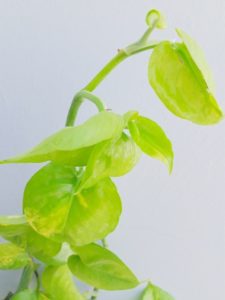Some links in the post are affiliate links and I get a commission from purchases made through some links found in the post.
Pothos is one of the best indoor plants that can be found in many households. Not only it is very beautiful, but also is a great air purifier that removes toxins.
You may already know that one of the most important things for plant growth is light. therefore, If you have a pothos plant or planning to get one, you must be wondering about pothos light requirements.
A pothos plant enjoys moderate light and prefers to have indirect sunlight. The amount of light can determine a lot of things, including its growth rate.
The plant is considered to be hardy and can withstand low light conditions too. However, for the best growth and health, moderate light is required. The perfect amount of time is 12 to 14 hours in a day.
Knowing that light requirements for a pothos is indirect bright light is not actually enough for its care and there is much more than that.
In this article, we will teach you how to choose the proper place for this beautiful plant and how is it affected by different kinds of light.
What Type of Light does my Pothos Need?
 One of the most often practiced problems with plants is connected with light. Even experienced plant lovers sometimes struggle with choosing the appropriate light for their greenery.
One of the most often practiced problems with plants is connected with light. Even experienced plant lovers sometimes struggle with choosing the appropriate light for their greenery.
There are several expressions that describe the different kinds of light that are available for the plants. Those are sun, partial sun, bright indirect light, shade, and low light.
For example, some plants love bright indirect and direct sunlight. However, what about the houseplants with leaves such as pothos?
Sometimes, people say that their room does not have enough sunlight. how can be the “enough” described?
Different plants may have different light and sun requirements, however, all of them benefit from seeing the daylight and sky as much as possible.
Today, light is not actually well understood. Us humans light differently from plants. Plants need it for survival and for activation of chemical reactions.
If provided more than they prefer, they will eventually be burned and die. However, if provided less, then they will suffer and can not do the chemical reactions properly. So, what is a solution, and how to know what kind of light to choose?
As we already mentioned above, there are several different types of natural lights. let’s start with direct sun.
Type 1
Direct sun is called when the sun rays are hitting straight on the plant. This particular one is called Type 1 It means that there is a direct line of sight between the plant and the sun. This particular one is the most intense light among all.
The direct sunlight is so strong that most plants can only tolerate it for a certain amount of time and after two or three hours, they will start suffering. Some of the plants that enjoy the direct sun are cactus and succulents.
Type 2a
The second sunlight type, Type 2a is filtered light also known as diffused sunlight. This is when the sun is shining onto the plant parts and obstructs them.
For example, such light is created when the sun rays come in from the translucent curtain, or when the sun shines through the trees.
Type 2b
Reflected Sunlight is when the light hits the object first with a surface that receives direct sun and reflects it.
This particular one is referred to as type 2b. In this case, light does not hit the plant itself but indirectly hits it as a reflection.
Type 3
Skylight is the light type when the plant looks to the clear day sky.
This is easy to measure because if the sunlight amount changes throughout the day, the skylight remains the same and does not change. Skylight is considered to be type 3
Most houseplants, including pothos, enjoy the bright indirect sunlight. Bright indirect sunlight includes all types except type 1.
Therefore, if the plant sees the filtered or diffused light, the reflected sunlight, or the skylight, it all counts as a bright indirect light.
There are some things that will help you measure the light level that your plant receives.
For this purpose, you will need to size find out the size of the window, the distance of how far the plant is from the window, and even the angle of cardinal directions.
For example, some tropical plants like pothos love to be closer to the windows and you can use the white curtain to make the light indirect.
How Much Light Does a Pothos Need?
Pothos light requirements include the specific length of time when the bright, indirect light has to be provided. the perfect amount of time is 12 to 14 hours in a day.
You will have to control the direct light exposure during the day. preferably, your pothos plant should receive a maximum of 3-4 hours of direct sunlight in a day. If it receives more than the leaves will become bleached and burnt.
We discussed the types of lights that exist today, however, it is still difficult to determine which type of light is at your house or by the spot where you plant to put the pothos plant.
There are several methods that plant lovers use to determine the strength and type of light.
The easiest method to test the light strength is the hand shadow test. this method is the cheapest among all and will approximately tell you what you need to know.
For the test, you can use the sponged stick or any sensible object. For the best result, do the test around noon.
First of all, lay the white paper in the place where your pothos is going to be. hold the hand about a foot above the paper.

Spread your fingers widely (or the object that you are holding) and evenly and look at that shadow that appears on the paper. The more detailed the shadow is, the more intense the is light.
A clear and well-structured shadow means that the spot gets bright light. It is best if the light is indirect and the sun does not look at the spot straight away.
If the shadow is a little blurry and fuzzy, then you have a medium-light. If the shadow is barely recognizable, then you have a low light and this may not be the best place to put your pothos plant.
Specific pothos light requirements include that first of all, the plant must receive optimal light of 200 FC for good growth.
The minimum light that has to be provided for the maintenance of the plant is 100 FC. When facing the sun and getting direct sunlight, in the growth stage, the plant can get 3000 to 5000 FC light.
However, this has to be limited to a maximum of 4 hours. Shades that have a light level of 50FC or low can be tolerated too, however, in this case, the plant goes into survival mode.
It will result the disrupted growth and problems in the development of foliage.
What Happens if your Pothos gets too Little Light?
When pothos light requirements are not fulfilled and the plant gets too little light, a bunch of problems arise. first of all, the colors of foliage fade.
The pothos plant that has gold, pale yellow, and white in it, (variegated species) can be easily affected by little light.
Even though the plant is hardy and can tolerate low light, still, if it happens regularly, then some issues will eventually arise.
Some signs showing that your plant does not get enough light are the leggy growth and extended internodes. When the light is not enough, foliage extended and tries to reach the sunlight.
As a result, your pothos plants will slowly lean towards the light source and becomes bent. In order to correct the lean, you can turn the plant 180 degrees in the opposite direction.
Another sign of low light is the production of small leaves. low light causes the culprit. the plant can not perform photosynthesis and transpiration as it should and it results in a lack of energy and food.
Therefore, the pothos will not have enough energy to provide large and healthy leaves. Additionally, the new stem and plant growth may also be limited.
You may also like: Pothos N joy vs pearls and jade
What Happens if your Pothos gets too Much Light?
Too much light is more threatful for pothos than too little light. The direct light can cause damage to the plant’s foliage such as burned leaves and the leaves turning yellow and brown.
The severity of burns and risk is dependent on many factors including temperature, light, watering, humidity and etc. The sunburn mainly results in discoloration, curling, and wilting foliage.
One of the signs that the pothos gets too much light is the discolored leaves. Most likely, the heat from the sun and light will dry out the plants and leave them brown, burnt and fried.
The plant will start to wilt because it gets weak. However, in most cases, this can be fixed when the plant moves in the shade.
Another sign that the pothos gets too much light is if it has stopped producing new vines. When the pothos is stressed, it prohibits the foliage to create energy and becomes stunted and as a result, the plant looks dense.
Where to Place your Pothos to get the Best Light
Pothos plants can be placed in the offices, bathrooms, living rooms, dining areas and etc. it is best to accommodate it by the center of the home.
Pothos plants like bright light but, not a direct one. therefore, The best place to put them at home is by the east-facing windows or doors.
Make sure to put the plant a few feet away from the window or separate the light with a sheer curtain.
Will Pothos Grow in Shade?
 A pothos plant can tolerate low light and shade. The regular species can do fine in this kind of conditions, however, the variegated ones that have different colors will start to revert to green in low light.
A pothos plant can tolerate low light and shade. The regular species can do fine in this kind of conditions, however, the variegated ones that have different colors will start to revert to green in low light.
White parts of variegated plants are totally dependent on the green parts because they can not do photosynthesis as much.
Therefore, if the light condition is poor for them, to survive, the white parts will start to turn into green ones.
Jade pothos is one of the species that can do well in low light. However, as we already mentioned above, the low light will cause plants to stretch and cause to generate much less energy for growth.
Therefore the growth of the pothos plant will most likely be interrupted.
Do Pothos do Well in Direct Light?
Pothos light need is high, however, it can not tolerate direct sunlight and will not do well in such conditions. Unfiltered and bright light will hit very harshly on its green foliage and will cause burns.
However, pothos enjoys the indirect bright sunlight for about 2 or 3 hours in a day. The best option and sun that you can give to your green friends is a morning sun and evening sun.
Can Pothos Grow in Artificial Light?
Most plants do not enjoy artificial light, however, pothos is not on that list. the artificial light works pretty well on pothos.
If you have it in an office or at home, where the natural light is very limited, pothos light requirements also are adjustable to the artificial light.
There are several types of artificial light available today, including incandescent light, LED light, halogen light, and horticultural growth light.
The best options that can satisfy pothos light needs are: fluorescent tubes and horticultural grow lights. The first one provides good white or full-spectrum lights, producing enough for pothos happiness.
Horticultural growth light has a full spectrum of wavelength and is also beneficial for pothos plants.
You may also like: How long do pothos live & how to increase the lifespan
How to Grow a Pothos using an Artificial Light
Before actually moving on to the use of artificial light, decide which one suits your plant the most. Get the light that you have chosen (or we have recommended above) from the store.
Install it so it looks straight to the plant. Remember to place it a little distance from the pothos plant to avoid overheating.
It is better to place the little mirror underneath the plant so the light can get reflected and spread to all foliage. Set the timer to at least 12 hours and that is it.
If you decide to use artificial light, also bear in mind that they release a high amount of heat, so it is appropriate to have them at a safe distance from the bulbs.
You can also turn the artificial light off at night and create a resting period. Since in most cases the artificial light is fixed on one specific spot, rotate your pothos plant so it can get even lights on all sides.
The best pothos light intensity of artificial lighting is above 5000 lux to a maximum of 21 500 lux, for a duration of at least 12 hours.
Final Thoughts
 Pothos plant is very hardy and it can withstand harsh conditions. Some species can even tolerate the shade.
Pothos plant is very hardy and it can withstand harsh conditions. Some species can even tolerate the shade.
However, If the appropriate light is not provided for these little green friends, then they will not be able to photosynthesise and can not produce energy that is essential for growth and health.
Pothos light requirements state that it needs to have bright indirect sunlight in order to thrive. If you want your pothos plant to be healthy and happy, give it adequate light.
The perfect length of light that needs to be provided in a day is from 12 to 14 hours. Direct sunlight must be limited and only exposed to maximum of 4 hours.
Too much sun exposure can cause burns and too little light will make the plant suffer. Therefore, the correct amount and perfect spot have to be chosen.

